When Do Babies Get Birthmarks
By: Nick Nguyen, Dr., FAAP & Sheilagh M. Maguiness, Medico, FAAD, FAAP
Gazing at your new baby, taking in every piddling item, is i of the many joys of parenthood. Among many unique features yous might notice is a birthmark, a unlike-looking spot on the skin that a baby is born with or develops presently after birth.
At that place are two main types of birthmarks: pigmented, spots of skin that contain extra pigment (color); and vascular, which contain actress claret vessels that didn't fully form. Both types are normally harmless, and some go abroad on their own. But some demand to be watched to make sure they don't cause bug. Exist sure to talk with your pediatrician nearly whatever birthmarks or rashes you notice on your baby.
Vascular Birthmarks—Pink, Red & Blueish
Pinkish, reddish, and blue birthmarks oft are made up of extra blood vessels. The extra claret tin can make some vascular birthmarks feel warm to touch. Vascular birthmarks may look and behave differently depending on the type of blood vessels in them. The most common claret vessel birthmarks include:
Nevus Simplex: "salmon patch," "angel osculation" & "stork seize with teeth" birthmarks
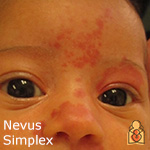 Nevus simplex are flat pink or carmine birthmarks that up to eighty% of babies are born with. They are collections of small, red blood vessels chosen capillaries. Often, these marks are located on the eyelids, forehead, back of neck, acme of head, under the nose, and lower back. Sometimes, they are chosen "salmon patch" marks, "stork bites" (when located on back of the neck) and "angel kisses" (when they're between the eyebrows).
Nevus simplex are flat pink or carmine birthmarks that up to eighty% of babies are born with. They are collections of small, red blood vessels chosen capillaries. Often, these marks are located on the eyelids, forehead, back of neck, acme of head, under the nose, and lower back. Sometimes, they are chosen "salmon patch" marks, "stork bites" (when located on back of the neck) and "angel kisses" (when they're between the eyebrows).
Nevus simplex birthmarks usually will go away on their ain by the time your babe is a toddler. Exercise not be alarmed if the birthmark gets darker when your baby becomes more than emotional or active—this is normal.
Most nevus simples are totally harmless and do not need treatment. Merely be sure to talk with your pediatrician if they are large or located in unexpected areas.
Port Wine Stains
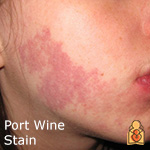
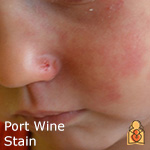 Port wine stains are fairly common, seen in most 3 in one,000 children. They are similar to nevus simplex: flat, pinkish or red birthmarks made upwardly of actress capillaries. They also are visible at birth. Just these birthmarks are commonly larger than nevus simplex and may affect more than areas of the face and body. Unlike some other birthmarks, port wine stains do not go away. They grow as your kid grows, but slowly. Over time, they may become darker and thicker.
Port wine stains are fairly common, seen in most 3 in one,000 children. They are similar to nevus simplex: flat, pinkish or red birthmarks made upwardly of actress capillaries. They also are visible at birth. Just these birthmarks are commonly larger than nevus simplex and may affect more than areas of the face and body. Unlike some other birthmarks, port wine stains do not go away. They grow as your kid grows, but slowly. Over time, they may become darker and thicker.
Port wine stains aren't usually linked to any health problems. If the birthmark affects a certain part of the face up, like the eyelid and brow, though, information technology may be related to a condition chosen Sturge-Weber syndrome. This condition is rare, but your doctor may recommend more evaluation or testing if your baby is at run a risk.
Some children and teens are not bothered by their port-wine stain, while others may feel self-conscious about them. Laser treatment may be able to lighten the birthmark some and help forestall concealment and thickening. But information technology will non "erase" the birthmark in most cases.
Infantile Hemangiomas
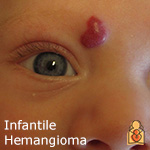
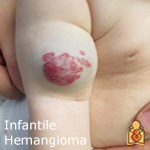 These benign growths, which usually appear in the beginning few weeks of life, are made of extra blood vessels in the skin. Infantile hemangiomas are fairly common--found in upward to 5% of infants. They usually grow chop-chop, and then gradually compress and fade. If they form nigh the superlative of the skin, they are red (and sometimes called "strawberry marks"). Deeper in the skin, they may wait bluish or purple, like bruises.
These benign growths, which usually appear in the beginning few weeks of life, are made of extra blood vessels in the skin. Infantile hemangiomas are fairly common--found in upward to 5% of infants. They usually grow chop-chop, and then gradually compress and fade. If they form nigh the superlative of the skin, they are red (and sometimes called "strawberry marks"). Deeper in the skin, they may wait bluish or purple, like bruises.
Infantile hemangiomas abound virtually quickly in the first 5-7 weeks of life, so information technology is important to talk to your pediatrician virtually them early. Some hemangiomas may be associated with certain wellness bug and require boosted testing and/or treatment. Safe treatments are available today for problem hemangiomas. But these treatments usually work best when started before long after these birthmarks form--generally by around 1 month age. Talk with your pediatrician if you call back your babe may have an infantile hemangioma.
Built Hemangiomas
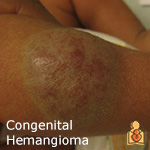 Built hemangiomas are present at nascence. Sometimes, they can be seen during prenatal ultrasound exams. They are unlike from infantile hemangiomas and much rarer. This type of hemangioma does non grow later the baby is built-in. Congenital hemangioma oftentimes wait similar a large round or oval bump or mass. They tend to be purple to blueish, but may also have tiny cherry claret vessels on the surface and a white ring around the base.
Built hemangiomas are present at nascence. Sometimes, they can be seen during prenatal ultrasound exams. They are unlike from infantile hemangiomas and much rarer. This type of hemangioma does non grow later the baby is built-in. Congenital hemangioma oftentimes wait similar a large round or oval bump or mass. They tend to be purple to blueish, but may also have tiny cherry claret vessels on the surface and a white ring around the base.
Some of these birthmarks begin to disappear speedily (a blazon called rapidly involuting congenital hemangioma). Some other type, not-involuting congenital hemangioma, does not get abroad at all. In most cases, built hemangiomas are non dangerous and do not need treatment. If the birthmark does non go away, it can be removed with surgery or other treatments when a child is older.
Venous Malformation
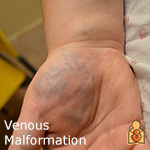
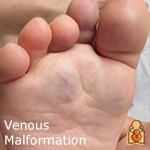 Venous malformations are tangles of veins in the peel that did not form properly during evolution. The veins give these birthmarks a blue or purple colour. They are present at birth but may not become obvious until the teenage years. The veins tin can become larger with activity or certain positions, and they may become painful. Venous malformations are rare, affecting effectually two in ten,000 children.
Venous malformations are tangles of veins in the peel that did not form properly during evolution. The veins give these birthmarks a blue or purple colour. They are present at birth but may not become obvious until the teenage years. The veins tin can become larger with activity or certain positions, and they may become painful. Venous malformations are rare, affecting effectually two in ten,000 children.
These birthmarks may cause no issues at all. But treatment may be needed if the birthmark is painful or affects your kid's activities. Sometimes, pocket-sized clots called phleboliths form in the veins. In most cases, these clots are not harmful but can exist difficult and crusade pain. Compression garments, medications, surgery or procedures may exist amid treatment options.
Most venous malformations are located just in the pare, only sometimes they tin also exist establish in muscles, bones, or organs. Your doctor may recommend a scan to get more than information nearly your child's birthmark.
Blood Vessel Birthmarks | ||
|---|---|---|
| What does information technology look like? | Does it demand to exist treated? | |
| Nevus Simplex |
|
|
| Port-Wine Stain |
|
|
| Infantile Hemangioma |
|
|
| Congenital Hemangioma |
|
|
| Venous Malformation |
|
|
Pigmented Babe Birthmarks—Brown & Grey
Brown and greyness birthmarks may be made of actress melanocytes—the cells that produce pigment (color) in the pare. Pigmented birthmarks can wait and conduct differently from each other. Some are harmless, but others can come up with health issues for your baby.
Congenital Melanocytic Nevi (Moles)
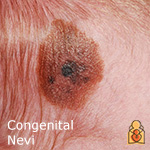
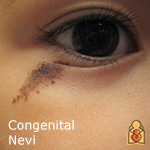 Congenital melanocytic nevi are usually called moles. They tin can be nowadays at birth or appear during the first year of life. These birthmarks are mutual, plant in i-3% of newborns. Built nevi tin wait very different from each other. Most are brown, just they may also have shades of pink, red, or black. Sometimes they have bumps or hair, and they may become rough or raised. Most congenital melanocytic nevi are harmless and usually do non require handling or removal. Many dermatologists and pediatric dermatologist simply monitor them at well-child visits. They can also tell you what changes you should sentry for in your child's birthmark.
Congenital melanocytic nevi are usually called moles. They tin can be nowadays at birth or appear during the first year of life. These birthmarks are mutual, plant in i-3% of newborns. Built nevi tin wait very different from each other. Most are brown, just they may also have shades of pink, red, or black. Sometimes they have bumps or hair, and they may become rough or raised. Most congenital melanocytic nevi are harmless and usually do non require handling or removal. Many dermatologists and pediatric dermatologist simply monitor them at well-child visits. They can also tell you what changes you should sentry for in your child's birthmark.
A nevi usually grows larger as your child grows, merely not quickly. They are classified based on their size: pocket-sized, medium and large/giant nevi. Large and giant nevi may have a higher risk for a type of skin cancer, melanoma, compared to small built nevi or other moles that appear later on in life. It's of import for all children, but especially those with this type of birthmark, to wear sun protection outdoors.
A child with more than than one congenital melanocytic nevus always needs to be evaluated by his or her pediatrician or pediatric dermatologist. Having more than than one congenital nevus at birth may be related to bug with the brain and spinal string. Your doctor may recommend a scan of these areas in this case, simply this is extremely rare. Acquire more and picket a video on identifying moles from The Society for Pediatric Dermatology.
Café-au-lait
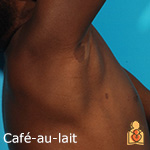 Café-au-lait means "coffee with milk," which describes the lite chocolate-brown color of these mutual birthmarks. Every bit many as 20-30% of people take one. The marks are flat and usually round or oval shaped. Most are smaller than a child's palm and take smooth borders. They are visible at nascency or develop very early in life.
Café-au-lait means "coffee with milk," which describes the lite chocolate-brown color of these mutual birthmarks. Every bit many as 20-30% of people take one. The marks are flat and usually round or oval shaped. Most are smaller than a child's palm and take smooth borders. They are visible at nascency or develop very early in life.
Most café-au-lait spots are harmless. They are unlikely to turn into skin cancer, merely may become darker with more than dominicus exposure. A large café au lait spot with jagged borders may exist linked with a rare genetic status called McCune-Albright syndrome. Multiple café-au-lait spots can be a sign of other conditions, including one called neurofibromatosis. If your child has a large café-au-lait spot, more than 5 spots, or spots in the armpits/groin, talk with your pediatrician about them.
Dermal Melanocytosis
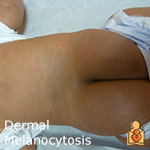 These are the most mutual birthmarks in babies with highly pigmented skin. They are seen in 85% of Asians, 96% of blacks & 46% of Hispanic babies at birth. They are commonly located on the lower dorsum and lesser, just some babies may take spots on different areas of the body. These birthmarks may be a mix of colors including dark-brown, gray, blue and blackness. Their unique color comes from having pigment in different layers of the skin.
These are the most mutual birthmarks in babies with highly pigmented skin. They are seen in 85% of Asians, 96% of blacks & 46% of Hispanic babies at birth. They are commonly located on the lower dorsum and lesser, just some babies may take spots on different areas of the body. These birthmarks may be a mix of colors including dark-brown, gray, blue and blackness. Their unique color comes from having pigment in different layers of the skin.
About dermal melanocytosis birthmarks, which used to be called Mongolian spots, gradually fade. Many disappear past the toddler years. The majority of them are harmless and do not demand handling. In rare cases, these birthmarks may be associated with genetic atmospheric condition. If your babe has other wellness problems and several spots, delight talk with your pediatrician.
Pigmentary Mosaicism
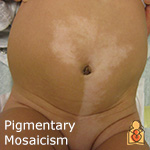 Mosaicism is a give-and-take that means two sets of Deoxyribonucleic acid, or genes, are nowadays in the aforementioned person. In pigmentary mosaicism, different genes might bear on the colour of the skin. These changes tin can be subtle or very large. Pigmentary mosaicism birthmarks accept unique patterns including lines and swirls. With sun exposure, areas can become lighter or darker.
Mosaicism is a give-and-take that means two sets of Deoxyribonucleic acid, or genes, are nowadays in the aforementioned person. In pigmentary mosaicism, different genes might bear on the colour of the skin. These changes tin can be subtle or very large. Pigmentary mosaicism birthmarks accept unique patterns including lines and swirls. With sun exposure, areas can become lighter or darker.
Even though the genetic alter involved with pigmentary mosaicism is present at nascency, the affected pare may not turn colour until afterwards in life. Sometimes sun exposure can cause this to happen. These changes tin requite the illusion that the birthmark is "spreading." In near children, pigmentary mosaicism is harmless. A small number of may have problems with the bones, optics or brain particularly if their birthmark covers a large area of their trunk, and then your pediatrician may recommend some tests.
Pigmented Baby Birthmarks | ||
|---|---|---|
| What does it look like? | Does it need to be treated? | |
| Congenital Melanocytic Nevi |
|
|
| Café-au-lait |
|
|
| Dermal Melanocytosis |
|
|
| Pigmentary Mosaicism |
|
|
Retrieve:
Most birthmarks are harmless and are part of what makes your child unique. But some types of birthmarks tin can come up with potential wellness problems or may cause some children to feel self-conscious. That'south why it is important to talk with your pediatrician about whatever unusual marks or changes on your child's peel. There are safety and effective handling options available today that are especially effective when started early.
Additional Information:
-
Infantile Hemangiomas: About Strawberry Baby Birthmarks
-
What is a Pediatric Dermatologist?
-
What is a Pediatric Plastic Surgeon?
-
12 Mutual Summer Skin Rashes in Children
About Dr. Nguyen:
 Nicholas Nguyen, MD, FAAP, is a pediatric dermatologist and the Director of Pediatric Dermatology at Akron Children's Hospital in Akron, OH. Inside the American Academy of Pediatrics (AAP), he is the early on career physician liaison to the Section on Dermatology Executive Commission and is also the AAP Pediatric Dermatology Case of the Calendar month editor.
Nicholas Nguyen, MD, FAAP, is a pediatric dermatologist and the Director of Pediatric Dermatology at Akron Children's Hospital in Akron, OH. Inside the American Academy of Pediatrics (AAP), he is the early on career physician liaison to the Section on Dermatology Executive Commission and is also the AAP Pediatric Dermatology Case of the Calendar month editor.
About Dr. Maguiness:
 Sheilagh Chiliad. Maguiness, Medico, FAAD, FAAP, is a pediatric dermatologist and the Manager of Pediatric Dermatology at the University of Minnesota, Minneapolis, MN. Dr. Maguiness is VP of Education and Career Development for the Society for Pediatric Dermatology. Within the American Academy of Pediatrics, she is a fellow member of the Department on Dermatology Executive Committee and is Chair of the Section on Dermatology Education Sub-Committee.
Sheilagh Chiliad. Maguiness, Medico, FAAD, FAAP, is a pediatric dermatologist and the Manager of Pediatric Dermatology at the University of Minnesota, Minneapolis, MN. Dr. Maguiness is VP of Education and Career Development for the Society for Pediatric Dermatology. Within the American Academy of Pediatrics, she is a fellow member of the Department on Dermatology Executive Committee and is Chair of the Section on Dermatology Education Sub-Committee.
The information contained on this Web site should not be used as a substitute for the medical care and advice of your pediatrician. There may be variations in handling that your pediatrician may recommend based on individual facts and circumstances.
When Do Babies Get Birthmarks,
Source: https://www.healthychildren.org/English/ages-stages/baby/bathing-skin-care/Pages/Your-Newborns-Skin-Birthmarks-and-Rashes.aspx
Posted by: valdezwhemere.blogspot.com


0 Response to "When Do Babies Get Birthmarks"
Post a Comment